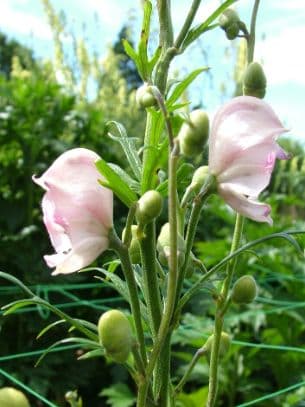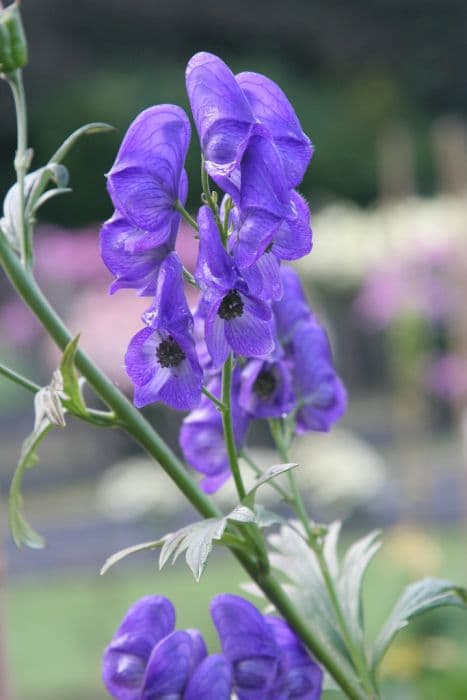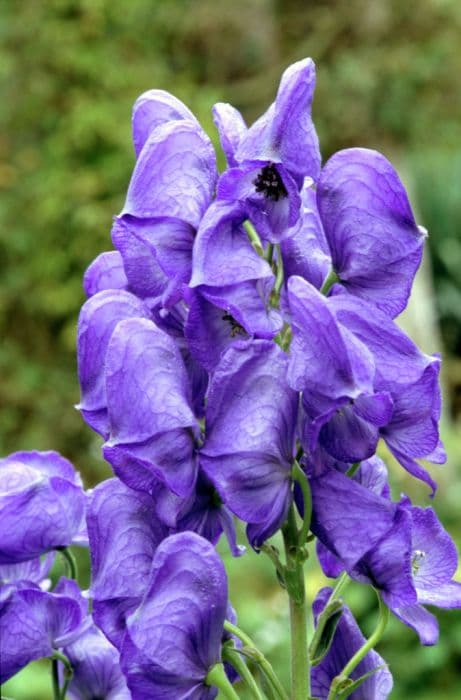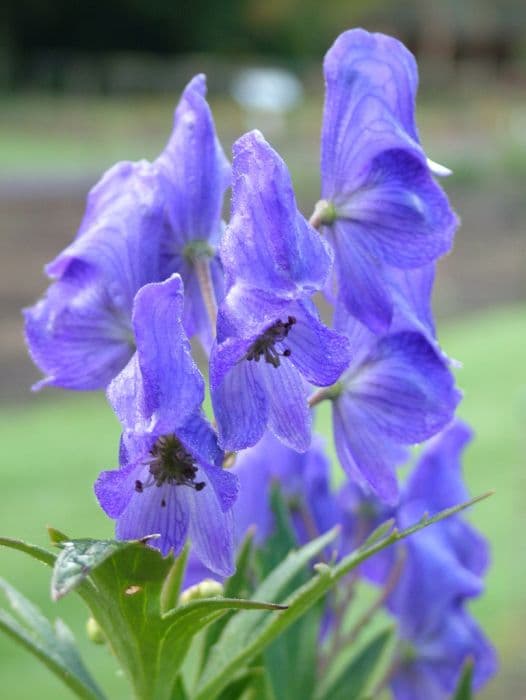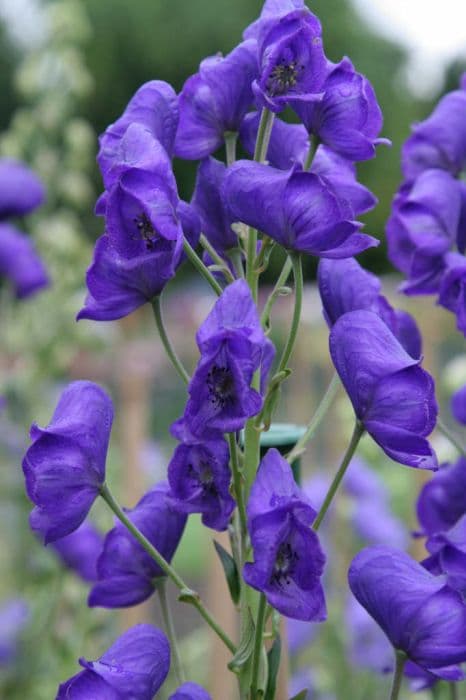Japanese Clematis Clematis 'Fujimusume' (EL)

ABOUT
Clematis 'Fujimusume' is a captivating plant known for its showy flowers which make a stunning visual impact in the garden. The blooms are notably large and possess a rich, velvety texture. They emanate a striking and vibrant shade of blue, a hue that appears both bold and delicate. Each petal is broad and overlapping, creating a near-perfect star-shaped form which contributes to their charm and aesthetic appeal. The center of the flowers feature a contrasting array of creamy-yellow to silvery stamens, adding a touch of elegance and intricacy to the overall floral display. These stamens are long, slender, and radiate from the heart of the bloom, drawing the eye inward and providing a pleasing contrast in colors. The foliage of Clematis 'Fujimusume' is also worth noting. The leaves are lush and green, providing a verdant backdrop that further accentuates the brilliance of the flowers. They are often compound, with leaflets emanating from a central point, creating an attractive, textured greenery that supports the visual interest of this cultivar even when it is not in full bloom. The plant is a climber, using its leaf petioles or tendrils to twine and cling to support structures such as trellises, arbors, or fences. This allows it to ascend gracefully, intertwining its greenery and blooms in a vertical display of ornamental beauty. Overall, Clematis 'Fujimusume' offers a stunning aesthetic with its oversized, vividly colored flowers and complementary green foliage. Its climbing nature enables it to transform vertical spaces into lush, blooming spectacles, making it a favorite among gardeners looking to add a touch of drama and natural elegance to their garden designs.
About this plant
 Names
NamesSynonyms
Japanese Clematis, Fujimusume Clematis.
Common names
Clematis 'Fujimusume' (EL)
 Toxicity
ToxicityTo humans
The Clematis, including the Clematis 'Fujimusume', contains compounds that can be toxic to humans if ingested. These compounds can cause symptoms such as nausea, vomiting, diarrhea, and salivation. The more severe effects might include mouth ulcers and skin irritation upon contact. In rare cases, if large quantities are consumed, it could lead to more serious symptoms such as internal bleeding or organ damage.
To pets
The Clematis, including the Clematis 'Fujimusume', is toxic to pets. Ingesting the plant can lead to symptoms such as drooling, vomiting, diarrhea, and possible mouth sores in animals. In severe cases, ingesting Clematis can cause lethargy, seizures, or even death. Immediate veterinary attention is advised if a pet has consumed any part of a Clematis plant.
 Characteristics
CharacteristicsLife cycle
Perennials
Foliage type
Deciduous
Color of leaves
Green
Flower color
Blue
Height
6-9 feet (1.8-2.7 meters)
Spread
3-4 feet (0.9-1.2 meters)
Plant type
Climber
Hardiness zones
4
Native area
Japan
Benefits
 General Benefits
General Benefits- Ornamental Value: Clematis 'Fujimusume' adds aesthetic appeal to gardens with its large, blue-violet flowers.
- Vertical Gardening: Ideal for vertical gardening, it can climb fences, trellises, and pergolas, thereby maximizing garden space.
- Seasonal Interest: It blooms in late spring to early summer, providing seasonal interest in the garden.
- Attracts Wildlife: The flowers can attract pollinators like bees and butterflies, fostering a healthy ecosystem.
- Easy Pruning: Group 2 pruning category means it only needs light pruning, making it relatively low maintenance for gardeners.
- Variety in Landscaping: Can be used in a variety of landscaping designs from formal to cottage gardens.
- Shade Tolerance: Although it prefers full sun, it can tolerate partially shaded areas, offering flexibility in planting locations.
 Medical Properties
Medical PropertiesThis plant is not used for medical purposes.
 Air-purifying Qualities
Air-purifying QualitiesThis plant is not specifically known for air purifying qualities.
 Other Uses
Other Uses- Natural Dyes: The petals of 'Fujimusume' clematis can be used to produce subtle natural dyes for fabric, offering shades of purple and blue depending on the mordant used.
- Garden Sculpture Training: Growers can train 'Fujimusume' clematis vines to climb over sculptures or frameworks in the garden to create living art installations.
- Insect Habitat: The dense foliage and climbing nature of 'Fujimusume' clematis provide shelter and breeding grounds for beneficial garden insects.
- Photography Backdrop: The beautiful blooms of 'Fujimusume' clematis make it an ideal backdrop for garden photography and plant portraits.
- Wedding Decor: The flowers of 'Fujimusume' clematis can be incorporated into wedding decor, such as arches or table centerpieces.
- Educational Tool: 'Fujimusume' clematis can be used in educational settings, like schools or botanical gardens, to teach about plant growth and climber support requirements.
- Privacy Screening: When grown on trellises or fences, 'Fujimusume' clematis can provide a lush, living privacy screen for outdoor spaces.
- Floral Arrangements: Fresh or dried 'Fujimusume' clematis flowers can be used in floral arrangements to add height and interest with their distinctive blooms.
- Creative Crafts: Dried 'Fujimusume' clematis vines and flowers can be used in crafts such as wreath making or for other decorative purposes.
- Seasonal Celebrations: 'Fujimusume' clematis can be incorporated into seasonal celebration displays, such as spring festivals or garden parties, due to its vibrant flowering.
Interesting Facts
 Feng Shui
Feng ShuiThe Clematis is not used in Feng Shui practice.
 Zodiac Sign Compitability
Zodiac Sign CompitabilityThe Clematis is not used in astrology practice.
 Plant Symbolism
Plant Symbolism- Ingenuity: Clematis, including the 'Fujimusume' variety, often symbolizes cleverness or intellectual feats due to its intricate and intelligent way of climbing and supporting itself.
- Mental Beauty: The delicate and intricate flowers of the Clematis can symbolize the beauty of the mind or thoughts, highlighting inner beauty rather than external appearances.
- Artistic Inspiration: The stunning blooms of the Clematis 'Fujimusume' might inspire artists and creatives, representing a muse or source of artistic ideas.
 Water
WaterClematis, commonly referred to as 'Fujimusume', should be kept consistently moist but not overly saturated. Water this plant with about one gallon of water once a week during the active growing season, adjusting as necessary during periods of excessive heat or drought, where additional watering may be required. Over winter, reduce watering to match lower temperature and growth rates, ensuring the soil doesn't completely dry out. Even watering, aiming not to wet the foliage directly, will help maintain optimal health and avoid diseases like powdery mildew.
 Light
LightClematis 'Fujimusume' prefers a position where its foliage can enjoy full sun to partial shade, with at least six hours of sunlight a day being ideal. The best spot is where the top of the plant receives sunlight while the roots stay cool and shaded; this can be achieved by planting lower-growing shrubs or perennials around its base or using mulch to shield the root zone.
 Temperature
TemperatureThe clematis 'Fujimusume' thrives in temperatures between 65-75 degrees Fahrenheit, although it can withstand occasional dips down to 20 degrees Fahrenheit and high temperatures up to 85 degrees Fahrenheit. They are hardy in USDA zones 4-9 and to ensure they flourish, avoid locations where cold winds or hot summer temperatures might stress the plant.
 Pruning
PruningPruning clematis 'Fujimusume' is necessary to promote strong growth and flowering. This variety should be pruned in late winter or early spring before new growth begins. It's a Group 2 clematis, meaning light pruning is required — remove any dead or weak stems and reduce the height if necessary. Ideal pruning time is after the first flush of flowers has faded, which will stimulate a second blooming.
 Cleaning
CleaningAs needed
 Soil
SoilClematis, including 'Fujimusume', thrive best in well-draining, moisture-retentive soil with a pH range of 6.5 to 7.5. A good soil mix includes two parts garden soil, one part well-rotted manure or compost, and one part gritty sand or perlite to improve drainage.
 Repotting
RepottingThe Clematis 'Fujimusume' should be repotted every 2 to 3 years to replenish the soil and provide room for root growth. It's best done in late winter or early spring before the growing season starts.
 Humidity & Misting
Humidity & MistingClematis 'Fujimusume' prefers a moderate humidity level, which mimics their natural outdoor environment. Aim for a humidity level between 50% to 70% for optimal growth.
 Suitable locations
Suitable locationsIndoor
Provide bright indirect light, cool airflow, and support for climbing.
Outdoor
Plant in well-drained soil, full sun to partial shade, and provide climbing support.
Hardiness zone
4-9 USDA
 Life cycle
Life cycleThe Clematis 'Fujimusume', also known as Clematis, initiates its life cycle from a dormant seed which, after a period of stratification, germinates in spring to develop a root system and shoots. As the plant matures, it enters the vegetative stage, producing long, climbing vines and compound leaves during the growing season. Clematis 'Fujimusume' progresses to the flowering stage in late spring to early summer, where it shows off large, striking blue-violet flowers. After pollination, often by insects, the plant produces fruits known as achenes, each containing seeds, which are then dispersed by wind or foraging animals. The clematis then enters a period of senescence in late autumn, dying back to the ground in colder climates or becoming less active in milder regions. With the arrival of the next spring, the plant will break dormancy and begin the cycle anew, resuming growth from the roots or surviving stems.
 Propogation
PropogationPropogation time
Spring-Early Summer
The Clematis 'Fujimusume', commonly known as the Clematis vine, can be propagated through several methods, but the most popular among gardeners is layering, which is best done in the late winter or early spring. This technique involves bending a stem to the ground and covering a portion of it with soil, keeping the tip exposed. Over time, the buried section will develop roots, and once these are sufficiently established, usually after a growing season, it can be cut from the parent plant and transplanted to a new location. This method retains the characteristics of the parent plant, ensuring that the beautiful flowers of the 'Fujimusume' variety are reproduced in the new plants. Layering is especially preferred for Clematis since it does not require complex equipment and has a high success rate for this particular species.

